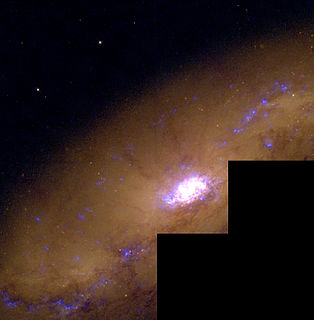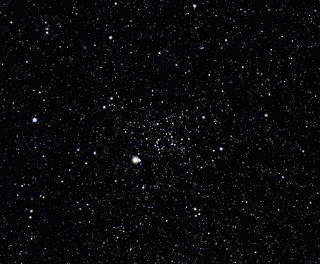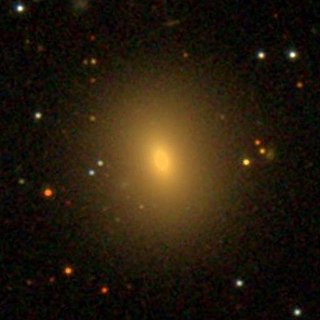
NGC 5866 is a relatively bright lenticular galaxy in the constellation Draco. NGC 5866 was most likely discovered by Pierre Méchain or Charles Messier in 1781, and independently found by William Herschel in 1788. Measured orbital velocities of its globular cluster system imply that dark matter makes up only 34±45% of the mass within 5 effective radii; a notable paucity.

NGC 2787 is a barred lenticular galaxy approximately 24 million light-years away in the northern of Ursa Major. It was discovered on December 3, 1788 by German-born astronomer William Herschel. J. L. E. Dreyer described it as, "bright, pretty large, a little extended 90°, much brighter middle, mottled but not resolved, very small (faint) star involved to the southeast". The visible galaxy has an angular size of 2′.5 × 1′.5 and an apparent visual magnitude of 11.8.

NGC 514 is a low-luminosity, intermediate spiral galaxy in the equatorial constellation of Pisces, located at a distance of approximately 83 million light-years from the Milky Way. It was discovered on 16 October 1784 by astronomer William Herschel. The general form of the galaxy is specified by its morphological classification of SAB(rs)c, which indicates it has a weak bar system at the core (SAB), an incomplete ring formation around the bar (rs), and somewhat loosely-wound spiral arms (c). This galaxy has an H II nucleus with an extended region that displays weak emission lines in the optical range, but not in the near infrared. The suspected supermassive black hole at the core has an estimated mass of 3.2×106 M☉.

NGC 5253 is an irregular galaxy in the constellation Centaurus. It was discovered by William Herschel on 15 March 1787.

NGC 2859 is a barred lenticular galaxy located some 83 million light years away in the constellation Leo Minor. The morphological classification is (R)SB(r)0+, where the S0+ notation indicates a well-defined physical structure that is lacking in visible spiral arms. It has a strong bar (B) of the "ansae" type, which means it grows brighter or wider toward the tips. A faint, secondary bar is positioned at nearly a right angle to the main bar. These features are surrounded by a weak inner ring (r) that appears diffuse. The outer region of the galaxy hosts a prominent, detached ring (R) that includes a series of blue-hued knots along the eastern side.

The NGC 5866 Group is a small group of galaxies located in the constellation Draco. The group is named after NGC 5866, the galaxy with the highest apparent magnitude in the group, although some galaxy group catalogs list NGC 5907 as the brightest member.

NGC 4319 is a face-on barred spiral galaxy located about 77 million light years away in the constellation Draco. The morphological classification is SB(r)ab, which indicates it is a barred spiral with an inner ring structure and moderate to tightly wound arms. It is situated in physical proximity to the galaxies NGC 4291 and NGC 4386, with X-ray emissions from the intervening gap indicating NGC 4319 and NGC 4291 may be interacting. NGC 4319 has a much higher proportion of ionized hydrogen compared to the Milky Way galaxy.

NGC 1808 is a barred spiral galaxy located in the southern constellation of Columba, about two degrees to the south and east of Gamma Caeli. It was discovered by Scottish astronomer James Dunlop, who described it as a "faint nebula". The galaxy is a member of the NGC 1808 group, which is part of the larger Dorado Group.

NGC 2060 is a star cluster within the Tarantula Nebula in the Large Magellanic Cloud, very close to the larger NGC 2070 cluster containing R136. It was discovered by John Herschel in 1836. It is a loose cluster approximately 10 million years old, within one of the Tarantula Nebula's superbubbles formed by the combined stellar winds of the cluster or by old supernovae.

NGC 1052 is an elliptical galaxy in the constellation Cetus. It was discovered on January 10, 1785 by the astronomer William Herschel. It is a member of the eponymous NGC 1052 Group.

NGC 4203 is the New General Catalogue identifier for a lenticular galaxy in the northern constellation of Coma Berenices. It was discovered on March 20, 1787 by English astronomer William Herschel, and is situated 5.5° to the northwest of the 4th magnitude star Gamma Comae Berenices and can be viewed with a small telescope. The morphological classification of NGC 4203 is SAB0−, indicating that it has a lenticular form with tightly wound spiral arms and a weak bar structure at the nucleus.

NGC 4494 is an elliptical galaxy located in the constellation Coma Berenices. It is located at a distance of circa 45 million light years from Earth, which, given its apparent dimensions, means that NGC 4494 is about 60,000 light years across. It was discovered by William Herschel in 1785.

NGC 2539 is an open cluster in the constellation Puppis, located at the north edge of the constellation. It was discovered by William Herschel on January 31, 1785. It is a moderately rich cluster and with little central concentration, with Trumpler class II1m.

NGC 5460 is an open cluster in the constellation Centaurus. It is a bright but loose cluster of intermediate age located approximately 2,300 light years away from Earth. It is located nearly 2 degrees east-southeast of Zeta Centauri.

NGC 1270 is an elliptical galaxy located about 250 million light-years away in the constellation Perseus. It was discovered by astronomer Heinrich d'Arrest on February 14, 1863. NGC 1270 is a member of the Perseus Cluster and has an estimated age of about 11 billion years. However, Greene et al. puts the age of NGC 1270 at about 15.0 ± 0.50 Gy.

NGC 2527 is an open cluster in the constellation Puppis. It was discovered by William Herschel on December 9, 1784. The cluster was also observed by John Herschel on January 7, 1831. He also observed it on February 5, 1837, identifying it as a different object, which was catalogued as NGC 2520. It is a poor cluster and with no central concentration, with Trumpler class III1p.

NGC 931 is a spiral galaxy located in the constellation Triangulum. It is located at a distance of circa 200 million light years from Earth, which, given its apparent dimensions, means that NGC 931 is about 200,000 light years across. It was discovered by Heinrich d'Arrest on September 26, 1865. It is classified as a Seyfert galaxy.

NGC 1375 is barred lenticular galaxy in constellation Fornax discovered by John Herschel on November 29, 1837. It is believed to be member of Fornax Cluster.

NGC 3393 is a barred spiral galaxy located in the constellation Hydra. It is located at a distance of circa 180 million light years from Earth, which, given its apparent dimensions, means that NGC 3393 is about 140,000 light years across. It was discovered by John Herschel on March 24, 1835. It is a Type II Seyfert galaxy. The galaxy is known to host two supermassive black holes, which are the nearest known pair of supermassive black holes to Earth.

NGC 4179 is a lenticular galaxy located in the constellation Virgo. It was discovered by William Herschel on January 14, 1784. It is a member of the Virgo Cluster.




















